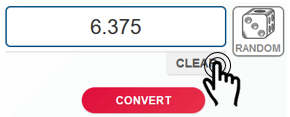- Calculators
- Basic Math
- Base Converters
Decimal to Base 11 Converter
DECIMAL TO BASE 11 CONVERTER (WITH STEPS)
Enter a number.

RESULT
(164)10 = (13A)11

DESCRIPTIONS
Divide the number repeatedly by 11 until the quotient becomes 0.
- When 164 is divided by 11, the quotient is 14 and the remainder is 10 = A.
- When 14 is divided by 11, the quotient is 1 and the remainder is 3.
- When 1 is divided by 11, the quotient is 0 and the remainder is 1.
Write the remainders from bottom to top.
(164)10 = (13A)11

OTHER INFORMATION
- Click here to see the binary equivalent of 164
- Click here to see the octal equivalent of 164
- Click here to see the hexadecimal equivalent of 164
INFORMATION
DECIMAL TO BASE 11 CONVERSION
WHOLE NUMBERS
We apply the following rules to convert a decimal number to base 11.
- We divide the decimal number by
11 repeatedly until the quotient becomes0 . - Starting at the least significant digit, we write the remainders in the same order of divisions.

For example, to convert decimal
When we divide
(
DECIMAL NUMBERS
In case, the decimal number is not an integer, we can convert the whole number and fractional parts separately and add the base
To convert the fractional part of a decimal number, we apply the following rules.
- We multiply the fractional part by
11 repeatedly until the product becomes an integer or the number of significant digits is sufficient for our calculations. - At each step, we write the integer part of the rightmost digit to the fractional part of the base
11 number. We continue with the fractional part of the product.
For example, to convert
0.36 ×11 =3 .960.96 ×11 =10 .560.56 ×11 =6 .16- .....................

The fractional part of
We continue with the fractional part of
The fractional part of
(
Base
(
= (
= (
WHAT IS DECIMAL TO BASE 11 CONVERTER?
Decimal to base 11 converter,
- Computes the base 11 equivalent of the entered decimal number and
- Describes each step of the conversion for both whole number and fractional parts,
HOW TO USE DECIMAL TO BASE 11 CONVERTER?
You can use decimal to base 11 converter in two ways.
USER INPUTS

You can enter a decimal number to the input box and click on the "CONVERT" button. The result and explanations appaer below the calculator
RANDOM INPUTS

You can click on the DIE ICON next to the input box. If you use this property, a random decimal number is generated and entered to the calculator, automatically. You can see the result and explanations below the calculator. You can create your own examples and practice using this property.
CLEARING THE INPUT BOX

To check the base 11 equivalent of other decimals you can clear the input box by clicking on the CLEAR button under the input box.
COPYING & DOWNLOADING THE SOLUTION

You can copy the generated solution by clicking on the "Copy Text" link, appaers under the solution panel.

Even you can download the solution as an image file with .jpg extension if you click on the "Download Solution" link at the bottom of the solution panel. You can share the downloaded image file.

- Calculators
- Basic Math
- Base Converters
Decimal to Base 11 Converter
RELATED LINKS
BASE CONVERTERS
DECIMAL TO BINARY CONVERTER
DECIMAL TO BASE 3 CONVERTER
DECIMAL TO BASE 4 CONVERTER
DECIMAL TO BASE 5 CONVERTER
DECIMAL TO BASE 6 CONVERTER
DECIMAL TO BASE 7 CONVERTER
DECIMAL TO OCTAL CONVERTER
DECIMAL TO BASE 9 CONVERTER
DECIMAL TO BASE 11 CONVERTER
DECIMAL TO BASE 12 CONVERTER
DECIMAL TO BASE 13 CONVERTER
DECIMAL TO BASE 14 CONVERTER
DECIMAL TO BASE 15 CONVERTER
DECIMAL TO HEXADECIMAL CONVERTER
DECIMAL TO OTHER BASES
BINARY TO DECIMAL CONVERTER
BASE 3 TO DECIMAL CONVERTER
BASE 4 TO DECIMAL CONVERTER
BASE 5 TO DECIMAL CONVERTER
BASE 6 TO DECIMAL CONVERTER
BASE 7 TO DECIMAL CONVERTER
OCTAL TO DECIMAL CONVERTER
BASE 9 TO DECIMAL CONVERTER
BASE 11 TO DECIMAL CONVERTER
BASE 12 TO DECIMAL CONVERTER
BASE 13 TO DECIMAL CONVERTER
BASE 14 TO DECIMAL CONVERTER
BASE 15 TO DECIMAL CONVERTER
HEXADECIMAL TO DECIMAL CONVERTER